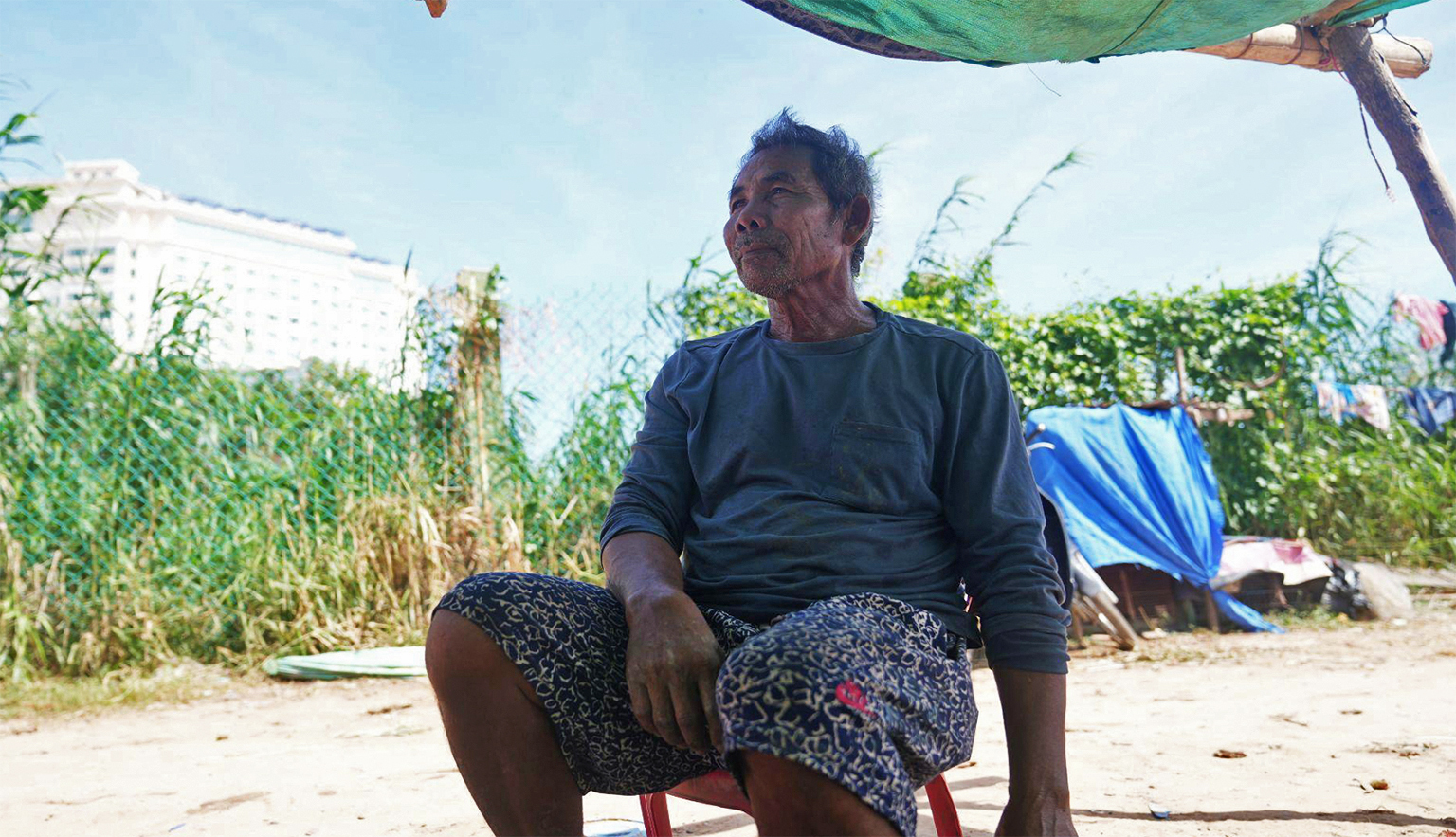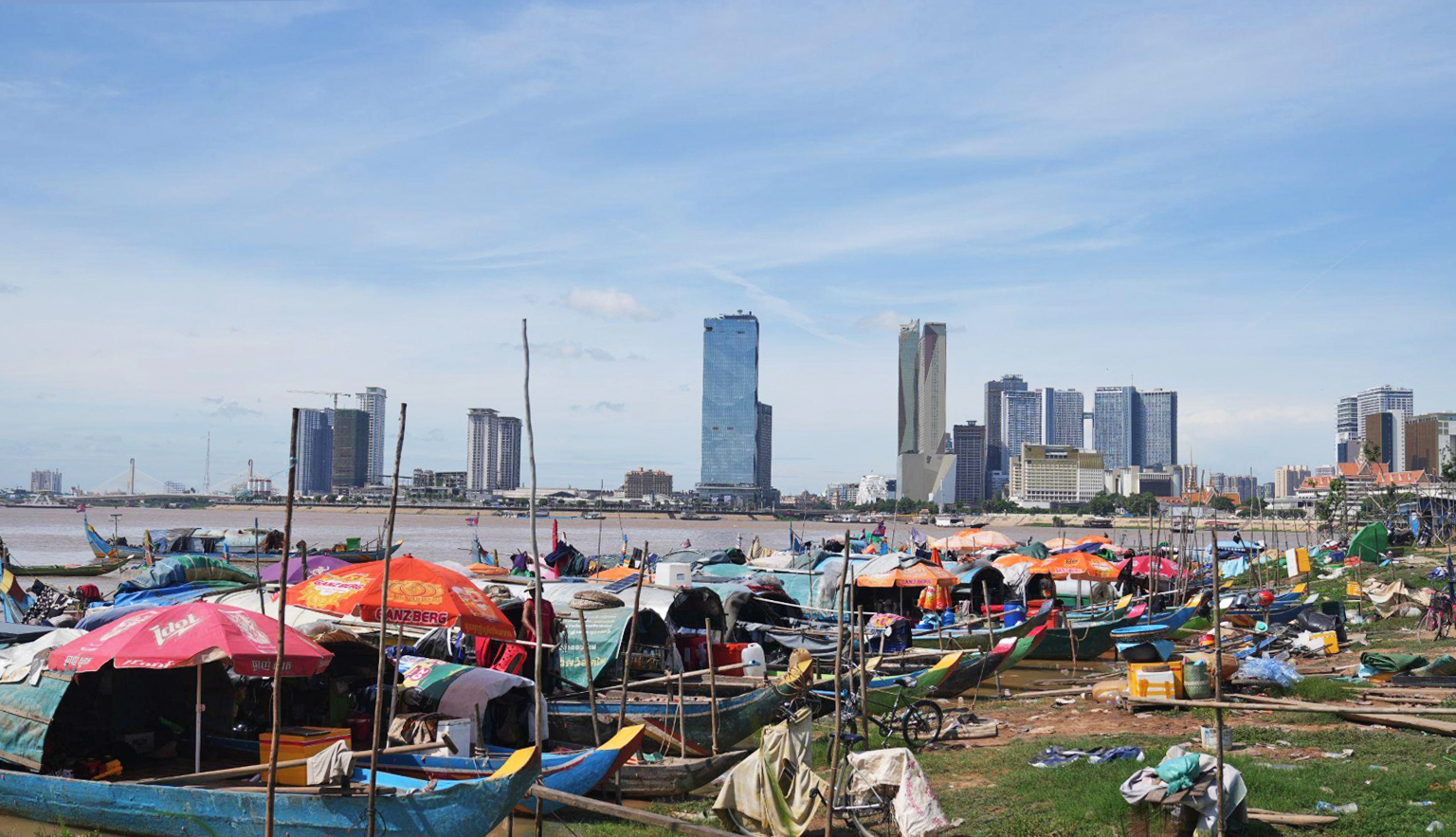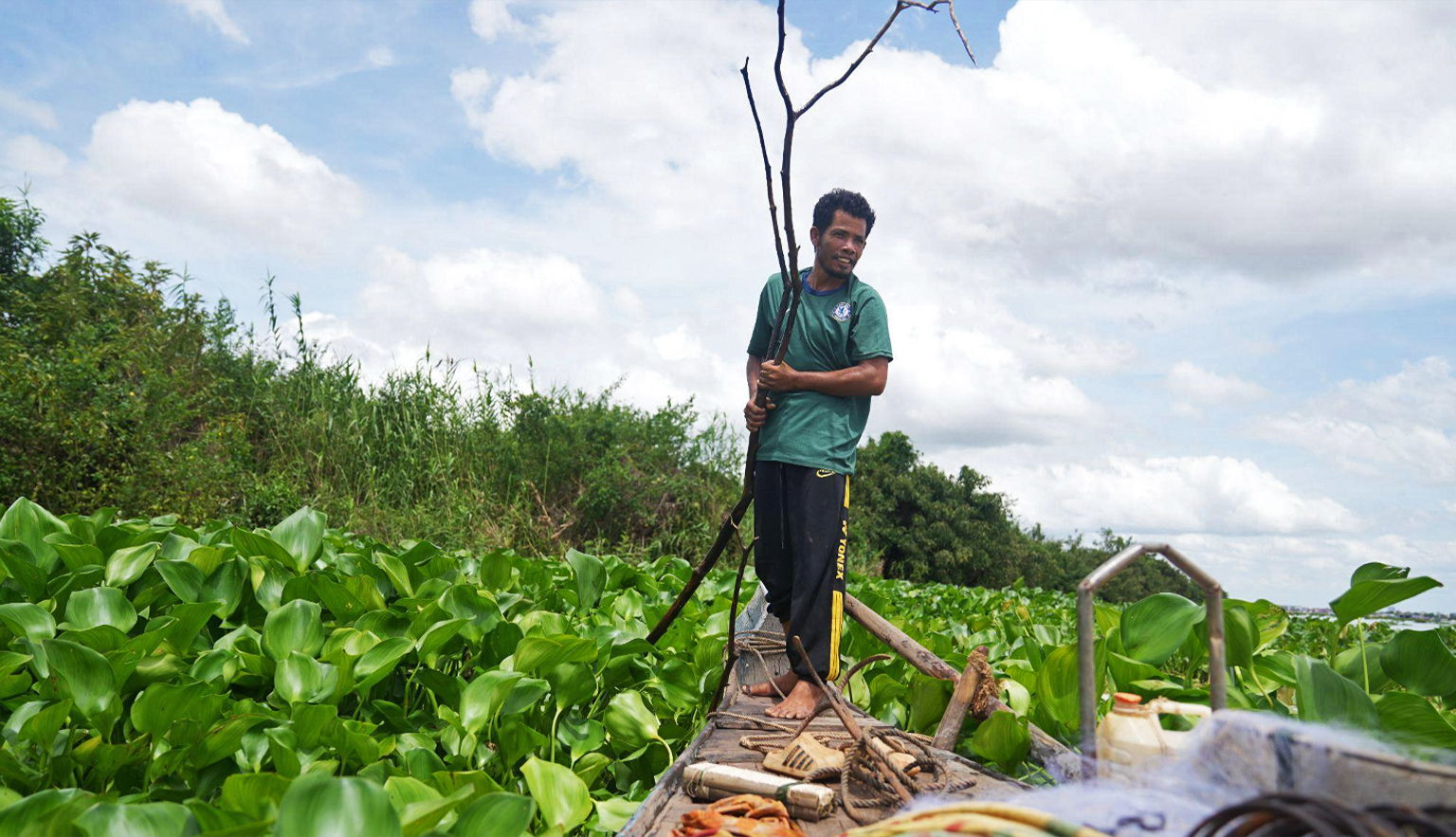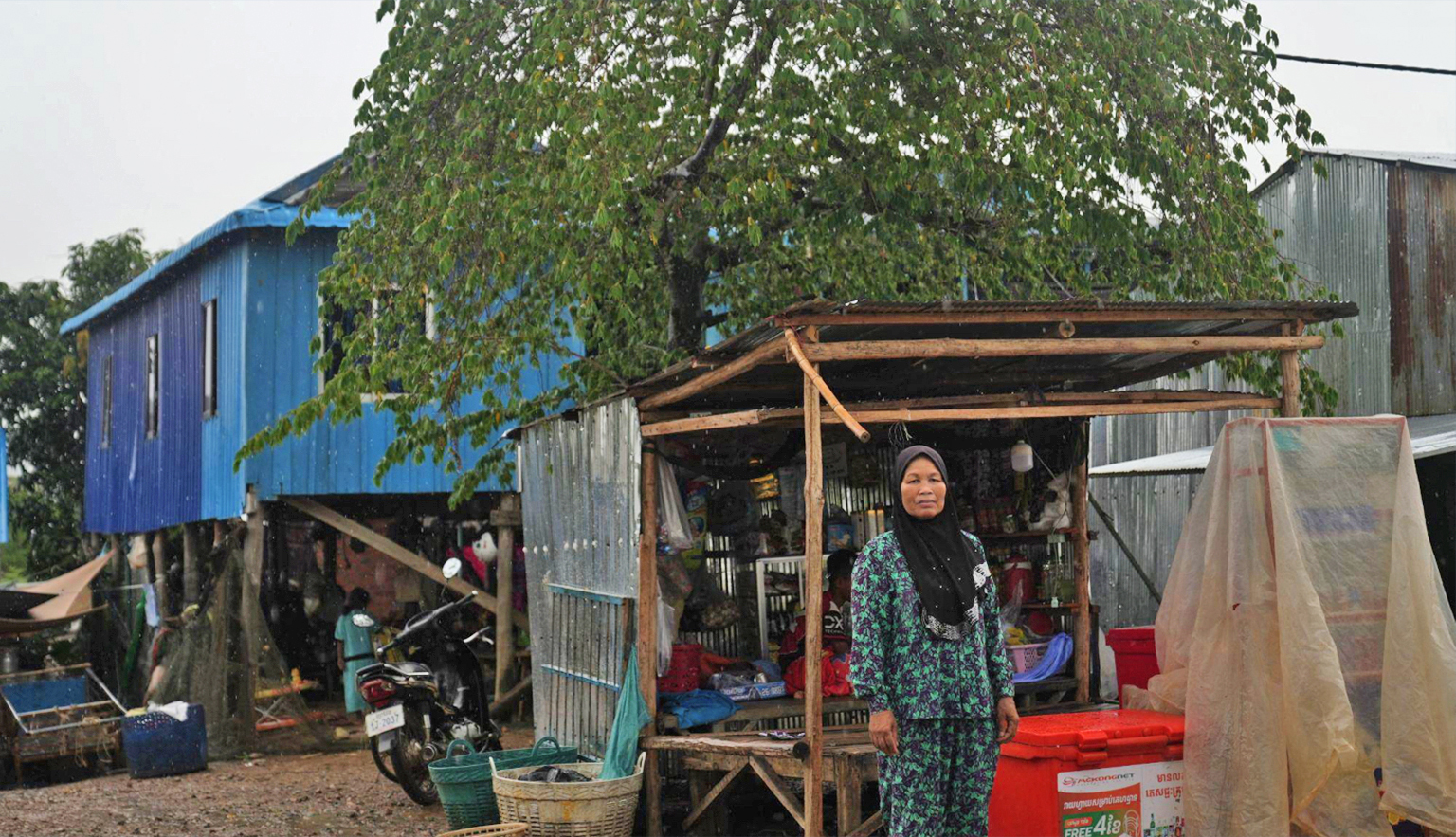- Ethnic Cham fishers in Cambodia say they face repeated evictions from their floating homes, often timed with major events and justified as environmental protection.
- They report unequal treatment by authorities, with harsher crackdowns on their small-scale fishing while larger, illegal operations go unpunished.
- Displacement and enforcement have pushed many into poverty, with little access to alternative livelihoods or support systems.
- Experts and advocates warn that current policies risk erasing Cham culture and call for more equitable, historically informed solutions.
PHNOM PENH — Mao Man, a 65-year-old ethnic Cham fisher in the Cambodian capital, Phnom Penh, says he isn’t sure how many times he’s had to relocate in his life, but he thinks he’ll be evicted again before the Water Festival this November. Today, he and his neighbors live on small wooden boats, which they moor behind a luxury hotel. Like many Chams, being relocated is a constant part of his life, and the lives of his ancestors. But now, the pressures to relocate come wrapped in the language of environmental protection.
“When I move, I float like a water hyacinth down the river,” Mao told Mongabay on July 6.

The Chams are one of Cambodia’s largest ethnic minorities, though they aren’t technically Indigenous people. They’re descendants of Champa, a collection of city-states that once ruled parts of southern Vietnam. After the last Cham state was annexed by the Đại Việt monarchy in 1835, and a campaign to forcibly assimilate and dispossess the Chams was instituted, many fled to Cambodia and settled along the Mekong River, converting to a unique form of Islam and taking up fishing. Today, about two-thirds of all Chams live in Cambodia.
Mao, like many others, has lived through decades of upheaval. During the Cambodian civil war, he had to flee his village in Kampong Cham, the province with the highest concentration of Chams. He eventually joined the military, which promised him land for his service. He said they never gave it to him, but instead gave him approval to build a floating house with other Chams on the river. Only a few years later, he and about 15 other Cham families were ordered to dismantle their homes.
“They said they had to prepare the city,” he told Mongabay. “If we did not dismantle it, they would set it adrift into the open ocean.”
Since then, Mao has been drifting, eventually docking his small boat, which serves as his work and family home, on a peninsula of Phnom Penh’s Chroy Changvar district with 100 other Cham families.
But beginning in 2019, authorities began evicting this community too.

“Honestly, they don’t want us here,” he said. “They come and say, ‘Let’s make this place quiet. Dock somewhere else.’”
At first, they tried to resist. But guards came and destroyed their belongings with knives, and beat members of the community, Mao said, forcing them to float out onto the river in stormy weather. He added this has happened perhaps a dozen times, but they always return quietly at night, and are generally left alone until the next eviction notice. Generally, these evictions coincide with major events, such as international summits or holidays, when Phnom Penh authorities want to present a better image of the city. In 2019, Al Jazeera reported that Chams had been ordered to leave to “lift up the reputation and beauty of Phnom Penh city.”
Some 100 kilometers (60 miles) up the river, in the province of Kampong Chhnang, similar forces are pushing another Cham community into poverty and dissolution. Ma Safi, a 31-year-old fisher, told Mongabay that over the past several years, he has faced increasing pressure from authorities. He used to live in a floating house as part of a larger multi-ethnic floating village, which included Cham, Viet and Khmer fishers living together. The community even received a modest income from tourists who were fascinated by their way of life. In 2014, the villagers were ordered to dismantle their homes due to environmental concerns, including plastic waste from their homes polluting the river. Since then, the community has been dispersed, and Ma said that tensions have increased between the different ethnic groups, who now live completely separately with little interaction.
The Cham fishers say they’re being overly prosecuted by the local fishery police compared to other groups. Ma told Mongabay reporters aboard the small fishing boat that’s now the only home for him and his family that increasingly aggressive fishery police have been harming their livelihood by cracking down and prosecuting their small-scale fishing methods in the name of environmental protection. He said that in June, soldiers confiscated his fishing nets for being too large. Before that, he could earn up to $50 a day. Now, he often earns as little as $17, leaving about $5 after expenses to support his family.
Meanwhile, Ma and other Cham fishers said that larger fishing operations backed by big companies are allowed to use far more destructive methods without interference, even though they operate just across the river. Ma pointed to where a noticeably more affluent fishing community consisting of ethnic Vietnamese were docked. He said they were regularly practicing samras or “brush park” fishing, which is illegal by Cambodian law and depletes the fish stock for everyone else. It involves bundling branches into underwater shelters that attract fish. These are harvested two to three times per year by completely surrounding them with nets. Ma said this method is regularly practiced by the Vietnamese fishers just across the river, but that they can afford to bribe the police and local journalists into ignoring it, while his community is prosecuted for its comparatively more sustainable fishing methods. This unequal enforcement, he said, has only deepened the resentment and made it harder for his community to survive.
A group of around six soldiers are stationed on the river, and patrol both day and night to find illegal fishing methods. One of the officers, a second lieutenant identified as Dara, told Mongabay that they had successfully reduced the amount of illegal fishing on the river.
“It is important to protect the fish stocks,” he said. “It is based on the laws given by the government.”
When asked about the lack of enforcement of samras fishing, Dara said that while samras fishing is illegal, it hasn’t occurred on the river since they started patrolling day and night. Despite this, Ma was easily able to find and take Mongabay reporters to a samras within a few minutes, and said there were many of them located along the banks of the river.

On top of this, like all the other Cham fishermen who spoke with Mongabay, Ma faces the ever-present threat of eviction. He reported that a few years ago he was ordered to move his fishing boat from where it’s docked near Kampong Chhnang City. He was able to appeal, and when a new governor was installed, he got temporary permission to remain.
“They didn’t give us any other reasons except saying this area is to be developed,” Ma said, recalling that he was told his community still harmed the environment.
Many Cham fishers have been forced to leave the river entirely, and are now struggling in makeshift shelters or overly cramped houses on land.
Ming Ah Sah, a 53-year-old Cham woman with eight grandchildren, tried to take matters into her own hands. She and others from four communities made a video appeal to Prime Minister Hun Manet in the hope that he would help if he knew their situation.
In her video, Ah Sah said she and her family have used the same fishing methods for years and were able to eke out a living. “We only fish manually, we don’t abuse the environment,” she said. In an interview with Mongabay, she explained how she has seen her livelihood slowly destroyed over the last decade.
She said it began when she and her family were kicked out of their floating village in 2015 because they “affected development and impacted the environment.” From then, she lived on a boat for a few years. But a few months ago, the soldiers took her fishing nets and the engine from her boat, which they said was illegal. Now, she shares a home not far from the river with three families, earning a meager income by repairing fishing nets for other Chams. She said she took out a $10,000 loan, which she’s now unable to repay because of her small income, and is begging the debt collectors to spare her.
So far, they’ve gotten no response from Hun Manet or anyone else in the government.
However, it’s not clear what the government could do about this situation.

Heng Kong has spent 25 years researching sustainable fishing in Cambodia and works for the Cambodian Ministry of Agriculture, Forestry and Fisheries. He acknowledged there are many challenges facing people who depend on fishing for their livelihoods. However, he said this may be unavoidable, calling it a “trend of the world.” He pointed out that the number of fishers around the world is shrinking, as is the availability of fish. He said that methods that are currently being made illegal, like samras, were traditional fishing methods for centuries. But as they’ve increased in scale, they’ve become unsustainable — even if they hadn’t been before. As individual fishing communities grow, he said, it becomes impossible for all of their children to maintain the same profession.
Heng also said that samras fishing was damaging to the environment, but not as much as other fishing methods, which are a higher priority for enforcement. However, he acknowledged there may be some inequalities in enforcement and said new fishing laws are being developed aim to address these concerns.
“We must protect the river’s resources for all the people, not just for rich people,” Heng told Mongabay on July 22. However, he emphasized that in light of trends, long-term assistance for Chams and other river-dependent communities must focus on helping them transition to alternative livelihoods on land.
Many Chams voiced concerns with this way of thinking, saying they should not be treated like other fishers. Ah Sah said that while the new fishing regulations may harm all ethnic groups equally on paper, in practice they affect Chams far more. She said she believes ethnic Khmers and Vietnamese often have connections outside the fishing industry and can rely on extended family or community networks to help them transition to life on land. In contrast, she said, most Cham fishers rely almost exclusively on the river for their livelihoods and lack the skills, education or social connections needed to find stable work away from the water.

“They have a connection to the river,” said So Farina, a Cham historian and head of the Cham Oral History Project at the Documentation Center of Cambodia. She said some Chams could live away from the river, but many always return to it.
So said she believes the government “had good intentions” but that it doesn’t “take history into consideration.” She said she hopes that by documenting the situation of the Chams, she can raise awareness so that people in power can understand that Cham fishers only need enough to survive, and should not be viewed as criminals.
However, she acknowledged that the problem was not easy to solve. Echoing the position of Heng, So said that “they cannot fish if there are no fish,” and that allocating land and providing education in new skills is one of the only ways to ensure a future for the Chams. However, she said that this type of decision can cause a lot of anxiety and be difficult to accept among the fishers themselves.
“For ethnic minorities, they are always afraid that they will lose their identities,” So said. However, she said she believes that Chams are resilient enough to overcome the changing world. She described the 150 years of Cham migration since Champa’s fall: “When they move, they build a community. One thing they never forget, they have it in their blood, is how to build a community wherever they are.”
Banner image: A fisher casts a small fishing net to catch fish for his family outside Phnom Penh, 2024. Image by AP/Heng Sinith.
Dam-building on Mekong poses risk to regional industries, report says





